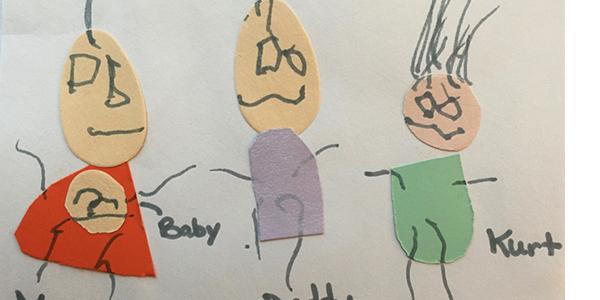Nurturing Wonder: STEM Projects Bring Joy to the Classroom

You are here
Propelled by their curiosity about the world, young children are constantly immersing themselves in STEM (science, technology, engineering, and mathematics) inquiries. They build and knock down block towers, they pull back grass and roll over rocks to see what’s in the ground, they take assorted objects to the water table to see what floats. When intentional teachers ask questions to expand children’s thinking and help them explore related vocabulary and concepts, children’s learning is enriched and their curiosity grows, fueling yet more inquiries.
These teachers are nurturing children’s sense of wonder—and their reward is a classroom full of children engaged in joyful, playful, and appropriately challenging learning.
From bucket brigades to toy making, this Young Children cluster is full of innovative yet practical ways to make STEM projects a centerpiece of your curriculum. We begin with two articles that describe teachers’ initial experiences with engaging children in sustained explorations of STEM topics and methods.
Chronicling the challenges and triumphs of a group of preschool teachers as they are introduced to and use the project approach to teach STEM, Lea Ann Christenson and Jenny James offer a case study in how to transform instruction. “Transforming Our Community with STEAM” reveals details of the difficult—yet invigorating—process in which their old Our Community unit changed from a few teacher-directed days to a month of child-directed investigation into firefighting as a profession and the science and collaboration necessary for firefighters to do their job.
In “Infant and Toddler STEAM: Supporting Interdisciplinary Experiences with Our Youngest Learners,” Eric Bucher and Stephanie Pindra present the result of a teacher-research and professional development project in which Early Head Start educators learned what STEAM (STEM plus the arts) looks like for infants and toddlers. They found that “early STEAM experiences help develop wonder, persistence, communication, problem solving, and mental flexibility”—but this doesn’t happen automatically. The teachers honed their observation and documentation skills so they could determine the infants’ and toddlers’ interests and offer materials and experiences to extend their thinking.
Hopefully these teachers’ initiatives have you eager to enhance your STEM instruction too. The rest of the cluster focuses on tried-and-true approaches that can be adapted to a wide variety of educational settings.
Zachary S. Gold, James Elicker, and Barbara A. Beaulieu, in “Learning Engineering through Block Play: STEM in Preschool,” offer a framework for recognizing and cultivating the engineering inherent in children’s block play. The framework describes nine engineering play behaviors—like “testing solutions and evaluating designs”—along with examples of the behaviors and strategies to stretch children’s learning.
Turning from blocks to books, the next article also helps educators spot more STEM learning opportunities. In “Story Time STEM: Nurturing Children’s Joy and Wonder through Shared Reading Experiences,” Allison Hintz, Antony T. Smith, Kristin Gray, Erin Gannon, and Ashley Wishart give examples of three types of books that can be used to engage children in STEM knowledge building, vocabulary development, and problem solving. They also provide strategies for examining science and math ideas as a regular part of read alouds and discussions.
If you are looking for more support, “STREAM Education at Work—No, at Play! A Toy-Making Unit” by Douglas H. Clements, Julie Sarama, Kimberly Brenneman, Nell K. Duke, and Mary Louise Hemmeter will help. It describes well-researched curriculum that centers STEM inquiries to support all aspects of preschoolers’ academic, social, and emotional development. Called Connect4Learning, this curriculum also involves literacy and the arts, so it is truly a STREAM approach. The article focuses on one unit in which children must solve several design and construction challenges to make toys for other classrooms. It also has tips for teachers to create their own STREAM units.
As all of these projects show, children find joy in both the processes and outcomes of learning. Like the thrill of playing a game or completing a puzzle, STEM projects (with just enough teacher guidance) are fun, challenging, and satisfying. Moreover, persisting with STEM projects develops the knowledge, skills, motivation, and mindset needed in later grades and in life.
A Fond Farewell
After 3.5 wonderful years with NAEYC, I am shifting to another education organization—but NAEYC will remain in my heart, thoughts, and actions. You—NAEYC’s members—are a very special group. You care for and educate many of our nation’s most vulnerable children. You embrace children’s families and communities, bringing their funds of knowledge into your classrooms and into your lives. Through NAEYC events, publications, and digital platforms, you seek to learn from educators near and far. And by providing comments on NAEYC position statements and initiatives, you help lead the profession.
I’m grateful for every article submitted to Young Children and for every teacher who has welcomed me for a classroom visit. You’ve nurtured my wonder and curiosity, shared beautiful examples of the delight children take in learning, been honest about the difficulty of remaining in a career that is not adequately valued in our society, advocated for better pay and higher standards, and demonstrated what it means to be dedicated to each and every child. Thank you.
As NAEYC CEO Rhian Evans Allvin often says, onward!
—Lisa Hansel
 We’d love to hear from you!
We’d love to hear from you!
Send your thoughts on this issue, and on topics you’d like to read about in future issues of Young Children, to [email protected].
Would you like to see your children’s artwork featured in these pages? For guidance on submitting print-quality photos (as well as details on permissions and licensing), see NAEYC.org/resources/pubs/authors-photographers/photos.
Lisa Hansel, EdD, is the editor in chief of NAEYC's peer-reviewed journal, Young Children.
